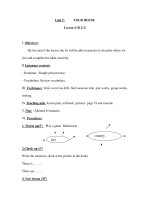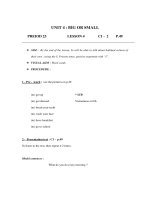4 3 2 friendly giants california gray whales (expository nonfiction)
Bạn đang xem bản rút gọn của tài liệu. Xem và tải ngay bản đầy đủ của tài liệu tại đây (1.74 MB, 6 trang )
Reader
Friendly
Giants:
California
Gray Whales
by Sanjay Patel
Genre
Expository
Nonfiction
Build Background
• Gray Whale Facts
• Whale Migrations
• Communication
Access Content
Extend Language
• Captions
and Labels
• Definitions
• Diagram
• Map
• Whale
Migration
Words
• Irregular Plural
Scott Foresman Reading Street 4.3.2
ì<(sk$m)=bebjic< +^-Ä-U-Ä-U
ISBN 0-328-14198-4
Talk About It
Friendly Giants:
1. Why are the Baja California lagoons good places
for the California gray whale to give birth?
2. How does blubber help the gray whale survive the
cold?
by Sanjay Patel
California Gray Whales
Write About It
3. Think about what it’s like to touch a whale. Then,
on a separate sheet of paper, write about how a
person touching a whale might feel.
What it is like
to touch a whale
How a person
might feel
Extend Language
The word calf is used for a young cow and for a
young whale. What is the plural form, for naming
more than one calf?
Photography Credits: Cover, 2 ©D. Fleatham/UNEP/Peter Arnold, Inc.;
1, 6 ©Stephen Frink/CORBIS; 5 (T) ©Martin Camm/Dorling Kindersley Media Library;
5 (B) ©Dorling Kindersley Media Library; 7 ©Mountain High Maps ®/1995 Digital
Wisdom Inc.
ISBN: 0-328-14198-4
Copyright © Pearson Education, Inc.
All Rights Reserved. Printed in the United States of America.
This publication is protected by Copyright, and permission should be obtained from
the publisher prior to any prohibited reproduction, storage in a retrieval system,
or transmission in any form by any means, electronic, mechanical, photocopying,
recording, or likewise. For information regarding permission(s), write to: Permissions
Department, Scott Foresman, 1900 East Lake Avenue, Glenview, Illinois 60025.
Editorial Offices: Glenview, Illinois • Parsippany, New Jersey • New York, New York
Sales
Massachusetts
• Duluth,
1234
5 6 7Offices:
8 9 10 Needham,
V0G1 14 13
12 11 10 09 08
07 06 05Georgia • Glenview, Illinois
Coppell, Texas • Sacramento, California • Mesa, Arizona
“The Friendlies”
Did you ever wonder what it feels like to
touch a whale? Many people who visit Laguna
San Ignacio know. That lagoon is located off
the coast of Baja California, Mexico. California
gray whales visit Laguna San Ignacio and other
lagoons in the area every year. The whales
migrate from the coast of Alaska to those warm
lagoons to mate and have calves.
Laguna San Ignacio is the only place where
whales come up to boats so that the people can
touch them. The first time this happened was in
1976. It happened to a village fisherman named
Francisco Mayoral, who was fishing in his boat.
The whales always came close to his boat, but
never right up to it. But one day it happened—
one calf came up to the boat, and then its
mother followed.
Soon other whales were coming up to the
boats. The fishermen called them las ballenas
amistosas, which means “the friendly whales” in
Spanish. In English, these whales are now called
“the friendlies.”
People have many ideas about why “the
friendlies” come up to boats. Some of these
ideas are based on scientific study. Other ideas
are based on people’s feelings when they see or
touch “the friendlies.” While we don’t know why
the whales come up to the boats, we do know
many other facts about the gray whale.
calves: baby whales
2
3
Gray Whale
Facts
Population: There are about 26,000 California
gray whales.
Size: The California gray whale is 35 to 50
feet long and weighs 40,000 to 80,000 pounds.
Newborn calves are about 15 feet in length and
weigh about 1,500 pounds.
Like all whales, the gray whale has a thick
layer of blubber to keep it warm. This layer can
be ten inches thick during feeding time. It gets
thinner when the whales cut down on eating
to migrate.
Feeding: Gray whales eat the tiny creatures
that live near the bottom of the ocean. When
they are feeding, they can eat a ton of food
a day!
When gray whales feed, they suck sand into
their mouths. Then, with their tongue, they push
the sand out of the sides of their mouths and
through the baleen. The creatures that were in
the sand get trapped in the baleen. That is how
the whales get their food.
blubber: fat
4
hairy bristles
help the whale
feel its way
around
two blowholes
tail, or fluke
flippers
35–50 feet long
The gray whale has a long, narrow shape that helps it
move through the water faster.
baleen
Instead of teeth, the gray whale has plates of baleen
which work like combs to filter the whale’s food.
5
Migration: California gray whales make
one of the longest migrations of any mammal.
The distance they travel can be up to 14,000
miles round trip. California gray whales spend
the summer feeding in the arctic waters off
Alaska. In the fall, when those waters begin to
freeze over, the whales swim south to the warm
lagoons off the west coast of Baja California. This
journey takes two to three months, with most
whales getting to the lagoons around January.
They spend the winter there, finding mates and
having their calves. Then, in early spring, when
the calves are strong enough, the whales travel
back to the cold northern waters.
The salty water in the lagoons helps the calves float.
Calves: Female gray whales have one calf
every two years. The calves nurse for seven
months and can drink about 50 gallons of milk
each day. This helps them build up the blubber
they will need for the colder waters around
Alaska.
The calves stay with their mothers in the
lagoons for up to three months. The mothers
teach them to swim against the currents in the
lagoons. This is good practice for the calves,
because they need to be able to swim in the
strong currents of the open sea. They also need
to be good swimmers in the ocean to get away
from predators such as killer whales and sharks.
Migration route of the California gray whale.
Alaska
Canada
United
States
Major Whale Migration Routes
Summer Locations
Winter Locations
nurse: drink milk from their mother
6
Mexico
7
Talk About It
Facts and Feelings
The California gray whale is the only kind of
whale that does not give birth in the open sea.
Scientists wonder why the gray whales have their
calves in the Baja California lagoons instead.
They think it’s because in the lagoons the water
is warmer, saltier, and shallow. The salt in the
water helps the calves float until they learn to
swim. And predators can’t swim in shallow water,
so the calves are safe.
People who see “the friendlies” in Laguna San
Ignacio like very much that such a massive animal
comes near them. They like petting the whales,
whose skin feels rubbery.
Now that you know more about the California
gray whale, why do you think the whales come
to the lagoons every winter?
shallow: not deep
rubbery: like rubber
Extend Language
Whale Migration Words
These words can be used to describe the migration of
gray whales.
Verbs
Nouns
Adjectives
1. Why are the Baja California lagoons good places
for the California gray whale to give birth?
2. How does blubber help the gray whale survive the
cold?
Write About It
3. Think about what it’s like to touch a whale. Then,
on a separate sheet of paper, write about how a
person touching a whale might feel.
What it is like
to touch a whale
How a person
might feel
Extend Language
The word calf is used for a young cow and for a
young whale. What is the plural form, for naming
more than one calf?
Photography Credits: Cover, 2 ©D. Fleatham/UNEP/Peter Arnold, Inc.;
1, 6 ©Stephen Frink/CORBIS; 5 (T) ©Martin Camm/Dorling Kindersley Media Library;
5 (B) ©Dorling Kindersley Media Library; 7 ©Mountain High Maps ®/1995 Digital
Wisdom Inc.
ISBN: 0-328-14198-4
Copyright © Pearson Education, Inc.
• long
• journey
• stay
All Rights Reserved. Printed in the United States of America.
• warm
• Pacific Ocean
• spend
• cold
• coast
• swim
• distance
• migrate
This publication is protected by Copyright, and permission should be obtained from
the publisher prior to any prohibited reproduction, storage in a retrieval system,
or transmission in any form by any means, electronic, mechanical, photocopying,
recording, or likewise. For information regarding permission(s), write to: Permissions
Department, Scott Foresman, 1900 East Lake Avenue, Glenview, Illinois 60025.
1 2 3 4 5 6 7 8 9 10 V0G1 14 13 12 11 10 09 08 07 06 05
8









